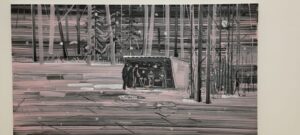Kunstmuseum Bonn (and the Bruno Goller Exhibit)
Last week, me and my friend Sam Owens went to the Kunstmuseum Bonn – the Bonn Art Museum. The museum was a beautiful experience that I absolutely recommend. A general admission ticket only costs 10 euro, and with a student id that price can be cut in half.
While museums have had a fascinating history (such as the many stolen artifacts from across the world) the Kunstmuseum focuses on Rheinish Expressionism and postwar German art. Like many other museums, the Kunstmuseum has an exhibition hall on the ground floor, with a permanent collection of modern art on the upper floor. Even the architecture of the building was fine tuned for this purpose. The final day of the exhibit we saw was January 19th, but we’ll definitely be back to see the next one!
The modern art on the second floor showcased one of the common themes we see in the contemporary and modern art movements: questioning the view as to what is considered art, and what art means. The exhibit was filled with paintings, but also had films, chairs, and maps. Much of the art showed objects distorted into a variety of ways, such as a piece showing torn fabric draped across a canvas or a map covered in color.

Photo of a painting from one of the modern art gallery on the upper floor of the museum. Photo Credit: Sam Owens
The Bruno Goller Exhibit was shown from September 19th, 2024 until January 19th, 2025. It showcased art from Bruno Goller from across his career, with a vaguely chronological order. The rooms were ordered in the stylistic movements of the artist. The first room showcased vaguely realistic portraits and muted colors. The rest of the exhibit – excluding the final room – showed deeply abstract paintings with a variety of subjects. While the placards describing each piece stated that the pieces were oil paintings on canvas, the smooth quality of the linework and the intensity of the color mimicked pastels. The final room of the exhibit showed the artist’s preparatory sketches. The art represented its subjects in fascinating ways: many of the pieces reminded me of M C Escher’s works despite the stylistic differences. The similarity is that both artists view the subject as something to be manipulated and stretched to form the necessary artistic purpose, rather than the subject as something to be captured as art. The exhibit did a wonderful job at showcasing an artist that I had never heard of and showcasing his artistic ability.
While I loved both the exhibit and the museum as a whole, my lack of German proficiency led me astray. Most of the text explaining the historical context of the paintings and exhibits was in German. Therefore, I personally didn’t get as much out of the museum as I would have liked. The museum is completely accessible to non-German speakers – but I like to read all the little plaques and explanations that the curators provide. I absolutely recommend this museum to anyone travelling in Bonn!
Au Revoir!
Carden
Sources:
https://www.kunstmuseum-bonn.de/en/
https://www.kunstmuseum-bonn.de/en/ausstellungen/bruno-goller/
https://www.britishmuseum.org/about-us/british-museum-story/contested-objects-collection
